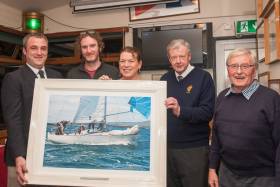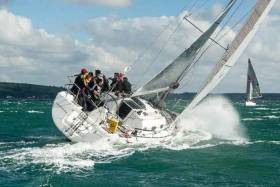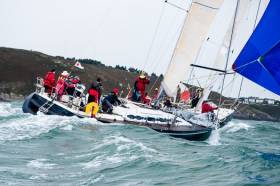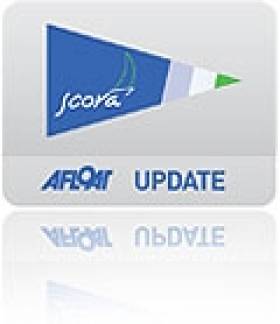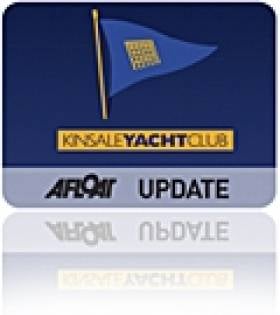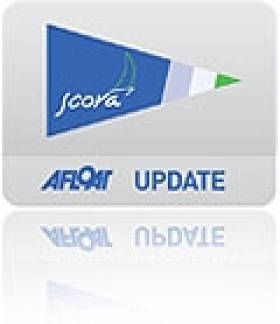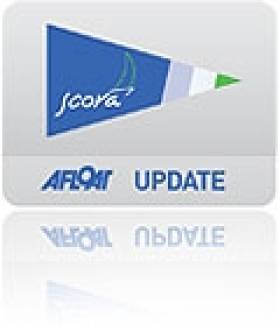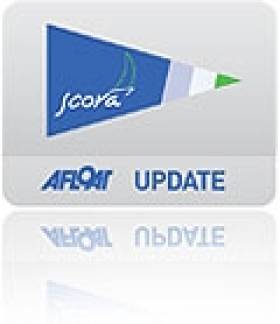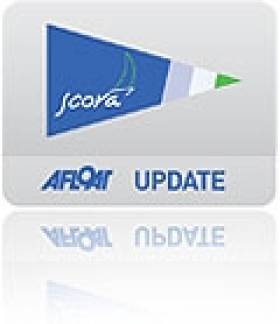Displaying items by tag: SCORA
69 Yachts Enter Cobh–Blackrock Race
69 yachts have entered for the Cobh-to-Blackrock Race tomorrow writes Tom MacSweeney. This is the annual sailing race from Cobh to Blackrock which once marked the end of the sailing season in Cork Harbour. It no longer is that end-of-season fixture, because the sport has expanded its horizons into December for cruisers and year-round now for some types of dinghies. But the ‘Cobh/Blackrock Race’ as it is known is still a big attraction for all sailors, even those who would not normally be of the ‘racing fraternity.’ The race caters for all types of sailing boats, from dinghies to cruiser/racers. It is the day when a flotilla of boats of all shapes and sizes assembles off Cobh and sails to the city.
Some boats choose to take part as a cruise, but must carefully watch and avoid the racers for whom it is also part of the SCORA (South Coast Offshore Racing Association) League.
The history of the race goes back to before the time of Haulbowline Bridge being built when it started off Ringaskiddy where boats from Cobh, where the RCYC was then based and the Royal Muster YC in Crosshaven met. This was because the Crosshaven boats had access there via the ‘back channel’ past Spike Island. The building of the bridge to Haulbowline Island in the mid-60ds ended that and the race was then started from Cobh. Cork Boat Club once had a sailing section in Blackrock which raced in Lough Mahon and around Blackrock and had a ‘Home Regatta’ every year.
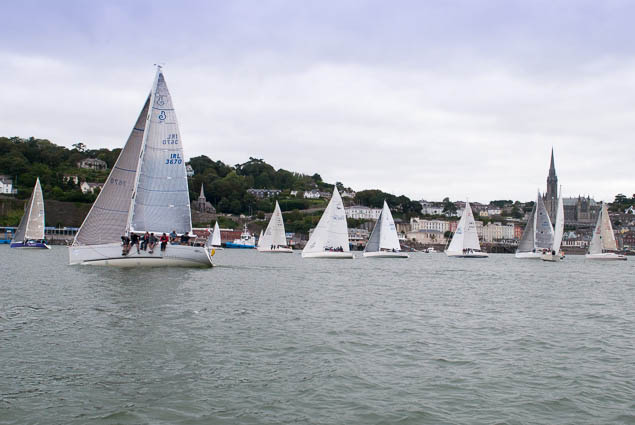 The ‘Cobh/Blackrock Race’ as it is known is still a big attraction for all sailors, even those who would not normally be of the ‘racing fraternity.’ Photo: Bob Bateman
The ‘Cobh/Blackrock Race’ as it is known is still a big attraction for all sailors, even those who would not normally be of the ‘racing fraternity.’ Photo: Bob Bateman
Until recent years the finish line of the race was off Blackrock Village which, depending upon the weather conditions, could be a struggle to reach having rounded Blackrock Castle! Afterwards boats moored against the Marina wall off Blackrock and the village was a colourful place as sailors gathered while the results were computed by Cove SC.
When Cork Port built its marina at the Custom House Quay and offered berthing after the race, the boats headed there after passing the finishing line set off Blackrock Castle.
That didn’t please the publicans in Blackrock, needless to say.
The race start will be off the Cobh Promenade. Cove Sailing Club are the organiser Mixed Dinghies and Dayboats will get their start gun first, at 1400 (2pm), followed by White Sail and then Class 1/2/3 cruisers and Sports Boats. The race is sponsored by Cork Port, Union Chandlery and the Sextant Bar.
The course is upriver from the start line at Cobh to the finish line at Blackrock Castle. “Competitors are advised to familiarise themselves with the navigation marks and depending upon weather conditions an extra leg may be included for specified Classes.”
The race time is chosen to suit the tide helping to carry boats towards Blackrock. But it has been known for some to go aground on mudbanks! From Lough Mahon there is the sight of Blackrock Castle, the delight of passing over the road traffic as it descends into the tunnel while the River Lee transports boats to the finish line.
SCORA Honours Memory of Sailing Journalist Claire Bateman
The South Coast Offshore Racing Association (SCORA) honoured Claire Bateman at its annual general meeting held in the Royal Cork Yacht Club last night writes Tom MacSweeney. Claire, who died last year, was a stalwart of sailing journalism for Cork Harbour and coastal racing sailors. Her coverage of cruiser and dinghy racing was comprehensive and her dedication to the sport charted its development. With photographer husband, Bob, the couple were ever-present at sailing events. Their coverage spanned from major events to the smaller ones, providing an unrivalled level of sailing reportage on Afloat.ie in national and local media and was the foundation of the RCYC website.
Members expressed appreciation of the dedicated work which Claire had done for sailing, as she was remembered by the presentation of a memorial award to the “most enthusiastic boat in SCORA.” This was a photograph of the winning boat, Dave Lane and Sinead Enright’s J24 ‘Ya Gotta Wanna’.
Making the presentation Claire’s son, Rob, recalled how his mother had been encouraged by well-known Cork Harbour sailor Michael Wallace into the role which she adopted with the dedication and commitment which marked her approach to whatever task she undertook.
That commitment benefited sailing for very many years and was much appreciated by SCORA sailors. Her death has been a huge loss to the sport.
Her husband, Bob’s photography, once again recorded the success of the top sailors in SCORA whose awards for their victories during the season, presented at the AGM, were framed photographs of their boats in racing action. Taken by Bob, these are treasured prizes. He continues the work of recording sailing and racing in Cork.
The newly-elected SCORA Commodore, Kieran O’Connell, is Rear Admiral for Keel Boat Racing at the RCYC.
There was a big attendance at the annual meeting which agreed that a review of SCORA and its racing programme was needed. This follows a year when “SCORA dropped off the map” the members were told. More co-operation between South Coast clubs is needed, delegates agreed, with an emphasis on “bringing the fun back into sailing”.
Falling numbers participating in events and the urgent need to change that, by bringing newcomers into the sport, particularly younger people, were identified as crucial issues.
SCORA AGM To Hear Proposal For Better Collaboration Between South Coast Sailing Clubs
Topics for discussion at next week's SCORA AGM and Presentation of overall prizes is a proposal for better collaboration between the local South Coast Clubs, which may help address the twin problems of falling fleet numbers and the poor number of youth dinghy sailors progressing to the cruiser scene.
The AGM will be held at the Royal Cork Yacht Club next Wednesday March 15th at 7.45pm.
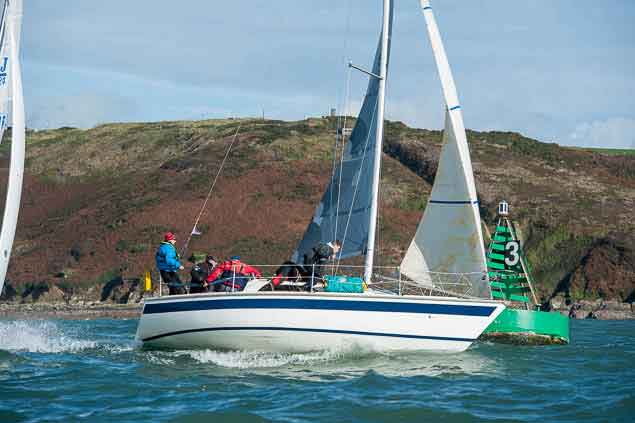 Judy Mc Grath's Impala 'Bonanza' with Barry Rose on the helm, rounds Cork Harbour's number 3 buoy
Judy Mc Grath's Impala 'Bonanza' with Barry Rose on the helm, rounds Cork Harbour's number 3 buoy
Several programmes were discussed at the recent ICRA conference and it is hoped to outline the various incentives available, which include cruiser training grants and the development of a new crew training curriculum.
A review of the current IRC class bands will take place with any possible alterations for the 2018 season.
The class winners of the overall SCORA league will be presented with a pictorial record, photographed by Afloat's Bob Bateman, at the various club events during the 2016 season. See a sample gallery below.
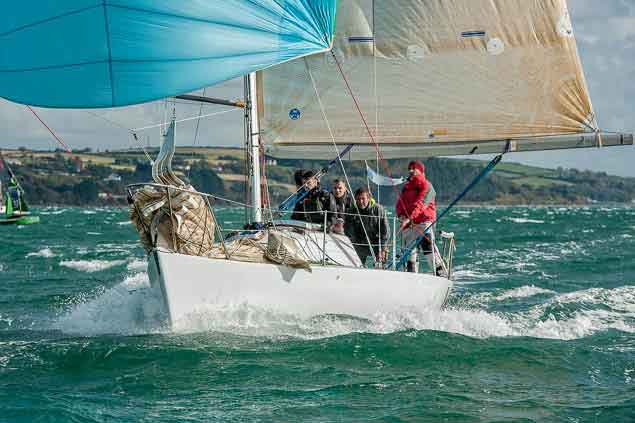 George Radley's half–tonner 'Coregada' finished third in IRC class two in SCORA overall and won IRC class 2 in CH Marine Autumn League
George Radley's half–tonner 'Coregada' finished third in IRC class two in SCORA overall and won IRC class 2 in CH Marine Autumn League
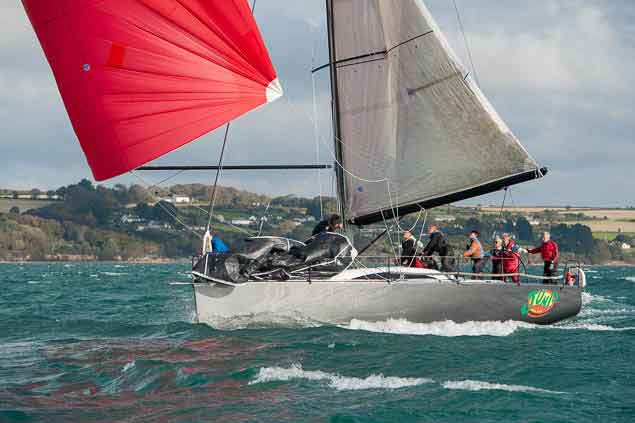 Jump Juice (Conor Phelan) in breeze
Jump Juice (Conor Phelan) in breeze
 Quarter Tonner Bandit (IRL 2611) leads the Sigma 33 Flyover
Quarter Tonner Bandit (IRL 2611) leads the Sigma 33 Flyover
 Frank Doyle's A35 Endgame, helmed here by Amy MacCarthy
Frank Doyle's A35 Endgame, helmed here by Amy MacCarthy
SCORA Sailors Head For Kinsale Yacht Club Hosted AGM
The South Coast Offshore Racing Association (SCORA ) Annual General Meeting will take place on March 11th, 2016, at Kinsale Yacht Club at 8pm writes Claire Bateman.
The agenda is set out below and it looks like there should be a good evening of discussion and plans for the coming season. Another topic that will come up is the future of club cruiser racing (if any) other than the big events like Spring and Autumn leagues.
The season is looking good all round in all classes with lots of interest being shown from the Juniors through to the Seniors.
Light refreshments will be served and there will be a chance to renew acquaintances and for those receiving prizes to enjoy the anticipation.
AGENDA
1. Apologies
2. Commodore’s Report
3. Income/Expenditure Account
4. Election of Commodore
5. Class Bands:
Class Bands for 2016
Class 0 1.050 and above
Class 1 1.049 to 0.975
Class 2 0.974 to 0.916
Class 3 0.915 to 0.865
Class 4 0.864 and below
This is NO CHANGE from 2015.
6. 2016 Sailing Programme – what do the competitors want?
7. SCORA – last year we asked what future?
8. Following the whitesail discussion last year – what next?
9. Any other business
10. Presentation of Prizes
Tributes Paid at SCORA AGM & Prizegiving Hosted By Royal Cork Yacht Club
#scora – The South Coast Offshore Racing Association (SCORA) AGM held at Royal Cork Yacht Club (RCYC) last Friday writes Claire Bateman.
A large and representative audience attended and the meeting was chaired by SCORA Commodore, Ronan Enright.
A minutes silence was observed to respect those members who had passed away during the year with special mention being made of the former very popular Class Commodore, Vinnie O'Shea who died during 2014.
Prior to going into the business of the evening, a special presentation was made to the Class Secretary, Jackie Kenefick, who was leaving the position Many tributes were paid to Jackie for all her efforts.
Having gone through the formal business of the meeting the floor was opened to the members and a discussion took place on the function of SCORA itself.
Cove Sailing Club's Commodore, Adrian Tyler, made a presentation on the new marina due to be open for the 2015 sailing season.
Following a break for refreshments the attendance had a brief discussion on Whitesail but the Commodore felt that as the Whitesail attendance would not be enough to represent the views of the Class, a further meeting would be called to discuss this item.
As there was no further business the meeting concluded with a slide show of the 2014 sailing season followed by the presentation of prizes.
#kinsale – Sunday's racing at Kinsale Yacht Club in County Cork was overshadowed by the sad passing of former Scora Commodore Vinnie O'Shea. Vinnie had been a great supporter of Kinsale Yacht Club and was well known as the Skipper of Yanks & Francs. A minutes silence was held as a mark of respect prior to the start of racing in the MMD April league.
KYC Commodore Finny O'Regan extended his sympathy to Vinnie's family on behalf of all the members of Kinsale Yacht Club.
While last Sunday's conditions may have brought many thrills and spills, today's proved to be much calmer with winds of around 10 knots. However conditions were described as tricky with frequent wind shifts. Competitors were also treated to glorious sunshine throughout the day.
Freya (Conor Doyle) and Godot (Godkin & O'Donovan) are both tying on 9 points in Class 0 IRC with Freya taking the lead due to a better result in the last race. Meridian (Tom & Ursula Roche ) lead Class 0 Echo by one point, with Godot currently in second place.
In Class 1 IRC Rob McConnell's Fool's Gold has a full row of bullets to give him a resounding lead over Dan Buckley's Justus. In Class 1 Echo, Joker ( Broderick & Gibbons ) has a lead of 2 points over Fool's Gold ( Rob McConnell ).
In Class 2 IRC, Bad Company (Desmond, Ivers & Deasy ) with 3 bullets out of a possible 4, has a lead of one point ahead of The Main 4 (Salter & O'Regan ). Bad Company also tie on points in Class 2 Echo with Silkbreeze ( Ernie Dillon). Silkbreeze takes first place having won the last race of the day.
The lighter winds seemed to suit Bandit ( Marron & O'Connell) well, and resulted in 2 bullets giving them the lead in Class 3 IRC over the Sigma Flyover (David Marchant). KYC are dominating Class 3 Echo with Chameleon (Padraig O'Donovan) taking a one point lead over Sammy Cohen's Gunsmoke 2.
Sundancer (Alan Mulcahy) has pulled ahead in both Echo and IRC in Class 4. The White Sail Classes had 2 late entrants today making Class 1 White Sails now the largest class in the MMD Spring Series. KYC's Reavra (Stephen Lysaght) has a commanding lead of 5 points over clubmate Peter Kelly's Magic Elphin. Michael Lynch's Lady T has the lead in Class 2 White Sails over Kevin Murray's Objection.
Racing continues next Sunday.
New SCORA Commodore Appointed at Kinsale AGM
#scora – Royal Cork Yacht Club's Ronan Enright was elected Commodore of the South Coast Offshore Racing Association (SCORA) at the cruiser racing association's agm at Kinsale Yacht Club at the weekend writes Claire Bateman.
Following two years at the helm of SCORA the very popular and hard working Vinnie O'Shea RCYC stepped down as SCORA Commodore and Ronan Enright of RCYC, proposed by the outgoing Commodore and seconded by John Stallard of KY was elected This was followed by the election of the three class captains resulting as follows: Class 1 Sean Hanley RCYC, Class 2 Pat Salter KYC and Class 3 Kieran O'Connell RCYC. The new Commodore then outlined the structure of SCORA and went through the programme for 2014.
The ICRA item on promotion of crew training and how to increase participation in cruiser racing was dealt with in a very professional manner by Denis Kiely who gave what can only be described as an impassioned presentation on the subject. This was listened to with great intensity by the large attendance and responded to with views from the various clubs. The study on this item is very much ongoing and ICRA will publish more detail as they study the matter and firm up on plans.
The attendance then enjoyed a slide show presentation and complimentary finger food before the presentation of the prizes.
The meeting was very well attended with representatives from Clubs all over the south coast with strong contingents from Waterford, Schull, Cove SC, Kinsale YC and of course RCYC and it was very heartening to see the interest displayed on all sides. SCORA is alive and well and new Commodore Enright is not about to delay as he has already announced plans to get the show on the road by holding a meeting very quickly with the Class Captains to get plans moving for 2014.
SCORA to Discuss Class Bands at Kinsale AGM
SCORA handicap bands for 2014 are on the agenda for the January 17th agm and prizegiving at Kinsale Yacht club but no changes from 2013 are proposed. The details for the meeting are as follows.
AGENDA
SCORA AGM and PRIZEGIVING
DATE: Friday 17 January 2014
VENUE: Kinsale Yacht Club
TIME: 1930
1. Apologies
2. Commodore's Report
3. Income/Expenditure Account
4. Election of Officers
5. Class Bands: At a meeting on 13 Nov 2013 it was agreed to put the following to the AGM
a. Class Bands for 2013 Class 0 1.050 and above
i. Class 1 1.049 to 0.975
ii. Class 2 0.974 to 0.916
iii. Class 3 0.915 to 0.865
iv. Class 4 0.864 and below
This is NO CHANGE from 2013.
6. 2013 Sailing Programme - format of 2013 programme and changes for 2014 programme
7. Discussion on ECHO/IRC management 2014
8. Report on ICRA Recruitment and Training Initiative
9. Any other business
10. Presentation of Prizes
SCORA Titles to Be Decided as Freya, Fools Gold & Eos Eye Top Prize
#scora – The SCORA League has been running throughout the season and events included the KYC April League, the Crosshaven/Baltimore race for Class One, Cobh to Blackrock for other classes and the CH Marine Autumn League at RCYC writes Claire Bateman.
Those in contention as of October 18th in Classes IRC Zero and One are Fools Gold, Freya and EOS. While in ECHO Zero and One Fools Gold, Freya and Exhale are also in contention.
Battling it out in IRC 2 are Slack Alice, Bad Company and The Main Four, while in ECHO 2 the same three boats are in contention in the same order again.
In IRC 3 we have Bandit, Flyover and An t Oileánach and in ECHO 3 we have Flyover, An tOileánach and Bandit in that order.
In Class 4 IRC and ECHO It's Sundancer, Shelly D and Thistle.
The committee are currently finalising arrangements for the SCORA AGM expected to take place in late November/early December and this date will be announced as soon as possible.
Quarter Tonners to Sail in Class Three SCORA, AGM Hears
#scora – The SCORA agm and prize giving at the Royal Cork yacht Club was well attended on Friday night last. It was a very positive and constructive meeting with a lot of interesting suggestions and thoughts put forward.
One of the big items for discussion was the Class Bands for 2013. After a lot of discussion it was put to a vote and agreed that Class Zero should be 1.050 and above, Class One should be1. 049 to 0.975 , Class Two should be 0.974 to 0.916, Class Three should be 0.915 to 0.865 and Class Four should be 0.864 and below. It was also agreed that future class bands break point will be revised from year to year to take account of IRC depreciation with a view to maintaining current class composition.
The question of the modified Quarter Tonners brought a lively discussion with a lot of different views resulting in a final agreement that they would sail in Class Three. Should the numbers warrant it, that is a minimum of four boats, they would form their own class receiving their own prizes.
SCORA Commodore, Vinnie O'Shea, made the point that the offshore racing on the east coast is doing very well but attempts at offshore racing down south were not very satisfactory this summer, but of course the appalling weather we had certainly did not help However, he was very keen to try again for 2013 with perhaps thirty to forty mile courses and there was a lot of support for this. With ICRA in Fenit this coming season, he was exhorting the troops with the dangling of a carrot of a number of feeder races. Cove Sailing Club offered to host a weekend championships for Classes Three and Four. The Sovereigns Cup will be in Kinsale in 2013 and all should make an effort to attend.
At the conclusion of the business of the meeting there was a short slideshow presented by Bob and Claire Bateman of the SCORA 2011/2012 season, much enjoyed by all, and was followed by the presentation of prizes and topped off with delicious finger food. All in all an excellent evening.





























